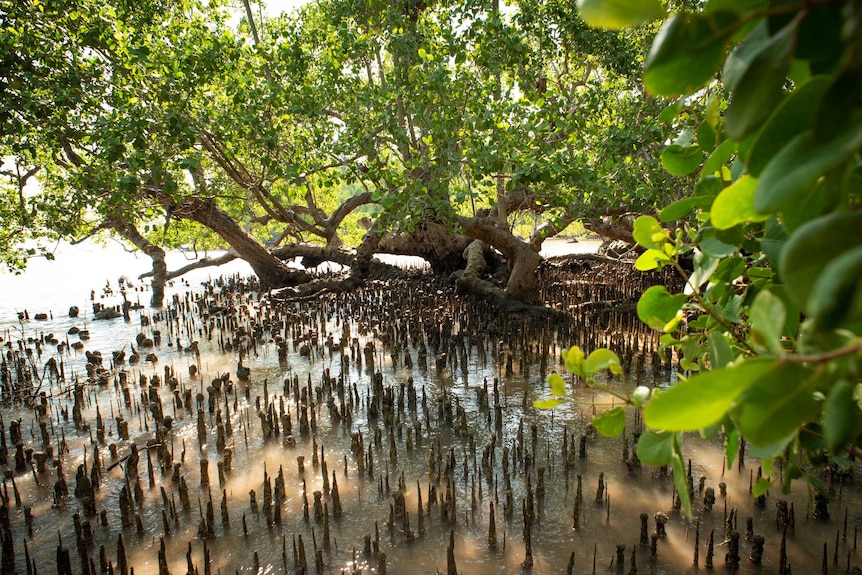Mangrove ecosystems in Australia are among the most valuable, diverse, and threatened coastal environments on the planet. Spanning over 11,000 square kilometers from the tropical north to the temperate south, these intertidal forests are not only biologically rich but also vital to Australia’s environmental resilience and economic sustainability. Whether protecting communities from coastal erosion, nurturing fisheries, storing carbon, or preserving Indigenous cultural heritage, mangroves deliver a suite of ecological services unmatched by most other ecosystems. Yet, they are rapidly declining due to urbanization, climate change, and industrial pressures, sparking urgent conversations around conservation, innovation, and Indigenous stewardship.
Australia is home to 41 species of mangroves, making it a global hotspot for mangrove biodiversity. These forests act as natural barriers, shielding over 120,000 coastal residents from storm surges and erosion—particularly in cyclone-prone regions like northern Queensland. Studies by the Australian Institute of Marine Science highlight how mangroves can reduce wave energy by up to 66% over just 100 meters, serving as a cost-effective and sustainable solution to rising sea levels. Moreover, organizations such as CSIRO have documented how mangroves stabilize coastlines and promote nutrient recycling, making them essential to marine food chains and water purification systems.
Their role in carbon sequestration is especially critical in the face of climate change. Research from Blue Carbon Lab at Deakin University shows that mangrove ecosystems in Australia can store up to 1.5 billion tonnes of carbon, with each hectare absorbing more CO₂ than an equivalent area of rainforest. Integrating mangrove protection into global carbon markets—such as through programs advocated by the Department of Climate Change, Energy, the Environment and Water—could generate economic incentives while enhancing Australia’s climate commitments.
Beyond their ecological utility, mangroves are cultural and economic linchpins. In regions such as Arnhem Land and Kakadu, Indigenous communities rely on mangroves for food, medicine, and spiritual practices. These communities are increasingly being recognized as co-managers of marine parks through partnerships facilitated by organizations like Parks Australia, blending ancient stewardship with modern conservation science. Additionally, the economic contribution of mangrove-related industries is substantial. According to the Australian Fisheries Management Authority, nearly 75% of commercially valuable fish species spend part of their lifecycle in mangroves, making these habitats indispensable to the nation’s AUD 3.15 billion seafood sector.
Despite these values, mangrove ecosystems in Australia are under siege. Reports by The Nature Conservancy Australia and WWF-Australia indicate that more than 3,200 hectares of mangroves have been lost since 2000, due to land reclamation, invasive species, heatwaves, and sea-level rise. Mass dieback events, like the catastrophic loss of over 7,400 hectares in the Gulf of Carpentaria in 2015, underscore their vulnerability to climate extremes. Innovations in restoration, such as drone planting and satellite monitoring championed by MangroveWatch, offer hope—but time is limited.
Mangrove ecosystems in Australia are more than just swamps—they are dynamic, productive, and foundational to the nation’s environmental health and coastal identity. Their preservation requires urgent policy support, robust science, Indigenous leadership, and public engagement—each an essential piece of a growing effort to ensure these ecosystems thrive into the next century.
The Vital Role of Mangroves in Australia’s Coastal Resilience
Natural Barriers Against Storm Surges
Mangrove ecosystems in Australia act as powerful buffers against storm surges and coastal erosion. Research from CSIRO reveals that mangroves can reduce wave height by up to 66% over a distance of 100 meters. This natural defense is particularly vital in cyclone-prone areas like northern Queensland, where mangroves protect over 85% of the shoreline.
Carbon Sequestration Champions
Mangrove forests are among the world’s most effective carbon sinks. According to Blue Carbon Lab at Deakin University, mangrove ecosystems in Australia store approximately 1.5 billion tonnes of carbon, making them essential allies in the fight against climate change. Per hectare, they can sequester up to four times more carbon than terrestrial forests.
Water Quality Enhancement
These ecosystems filter sediment and pollutants, improving water clarity and marine health. A study by the Australian Institute of Marine Science shows mangroves can trap up to 80% of terrestrial runoff, preventing it from harming sensitive habitats like the Great Barrier Reef. This natural filtration system supports marine biodiversity and coastal livelihoods.
Supporting Coastal Communities
Over 120,000 Australians live in areas directly benefiting from the protection and resources offered by mangrove ecosystems. In the Northern Territory, Indigenous communities rely on mangroves for food, traditional medicines, and cultural practices. These forests are essential for both ecological and human well-being.
Economic Value of Mangrove Services
The economic value of mangrove-related services in Australia is estimated at over AUD 1.2 billion annually, including fisheries, tourism, and coastal protection. With commercial fisheries depending heavily on mangrove nursery habitats, these ecosystems underpin industries vital to national and local economies. Mangrove ecosystems in Australia provide not only environmental but also substantial economic resilience.
Biodiversity Hotspots: Life Within the Mangrove Forests
Havens for Marine and Terrestrial Species
Mangrove ecosystems in Australia support an extraordinary variety of life. Over 2,000 species of fish, birds, reptiles, and invertebrates depend on these habitats. Notably, species such as mud crabs, barramundi, and the endangered proboscis bat thrive in these unique environments.
Critical Nursery Grounds for Fisheries
A CSIRO study found that 75% of Australia’s commercially important fish species spend at least one life stage in mangroves. Juvenile prawns and barramundi rely on these safe, nutrient-rich waters. Without mangroves, Australia’s AUD 3.15 billion fishing industry would face dramatic losses.
Rare and Endangered Species Refuge
Mangrove ecosystems in Australia are home to several rare species, including the mangrove honeyeater and the false water rat. In Kakadu National Park, mangroves provide one of the few remaining habitats for the threatened speartooth shark. Preserving mangroves is crucial for preventing extinction.
Interconnected Ecosystem Webs
The health of adjacent ecosystems like coral reefs and seagrass beds is directly linked to mangroves. Data from the Australian Institute of Marine Science shows that coral reefs located near healthy mangroves have 25% more fish biomass, proving their mutual ecological reinforcement.
Rich Plant Diversity
Australia hosts 41 mangrove species, representing more than half of the world’s known species. These trees adapt to extreme salinity and oxygen-poor soils, supporting a dynamic understory of ferns, fungi, and algae. Mangrove ecosystems in Australia thus represent some of the most biologically productive habitats on Earth.
Threats Facing Australia’s Mangrove Ecosystems
Climate Change and Rising Sea Levels
Mangrove ecosystems in Australia face severe threats from climate change. The Bureau of Meteorology reports sea levels rising at 2.1 mm per year along Australia’s northern coast, disrupting tidal flows vital for mangrove survival. These changes threaten to inundate root systems and alter salinity balances.
Deforestation and Land Development
Since European settlement, nearly 17% of Australia’s mangrove cover has been lost. Coastal urban development, particularly in New South Wales and Queensland, continues to encroach on mangrove habitats. Data from the Department of Climate Change shows 3,200 hectares of mangroves cleared between 2000 and 2020.
Pollution and Agricultural Runoff
Nutrient-rich agricultural runoff has led to algal blooms that suffocate mangrove roots. In the Gulf of Carpentaria, pollution has reduced mangrove canopy cover by 20% in certain regions. Pesticides and heavy metals in the runoff further disrupt reproductive cycles of marine life.
Extreme Weather Events
Cyclones and heatwaves have caused mass dieback in recent years. A 2015 heatwave led to the death of more than 7,400 hectares of mangroves in the Gulf of Carpentaria—one of the largest dieback events ever recorded. Mangrove ecosystems in Australia remain vulnerable to increasingly frequent climate extremes.
Invasive Species Disruption
Introduced species like the tilapia fish and the feral pig destroy native flora and disrupt the food chain. Studies by Queensland Parks and Wildlife Service show that feral pigs uproot mangrove saplings, reducing forest regeneration rates by 45%. Invasive species pose a growing threat to long-term ecosystem stability.
Conservation and Innovation: Safeguarding Mangroves for the Future
Government Protection Initiatives
Australia has designated more than 85% of its mangrove forests under national or state protection. Programs like the “Blue Carbon Futures” policy aim to integrate mangrove conservation into carbon offset markets, potentially generating millions in climate funding.
Indigenous Stewardship and Knowledge
Indigenous Australians have sustainably managed mangroves for thousands of years. In regions like Arnhem Land, Traditional Owners monitor ecosystems using seasonal indicators. Their knowledge has been integrated into over 50 co-managed marine park agreements, ensuring culturally informed conservation of mangrove ecosystems in Australia.
Restoration Projects and Success Stories
In New South Wales, community groups have successfully restored 120 hectares of mangroves since 2017. These efforts include sediment control, native planting, and ecological monitoring. One project in Botany Bay increased juvenile fish density by 35% within two years of restoration.
Technology and Remote Sensing Tools
Satellite data and drones are now widely used to track mangrove health. The MangroveWatch program, in partnership with James Cook University, utilizes real-time monitoring to detect deforestation and health decline across over 1,000 kilometers of coastline. Mangrove ecosystems in Australia are now better mapped than ever before.
Public Education and Community Involvement
Schools, councils, and NGOs are educating the public on the value of mangroves. Citizen science programs involving over 6,000 volunteers annually contribute to data collection and tree planting. These grassroots efforts ensure local stewardship and resilience of these critical coastal habitats.




